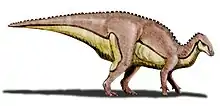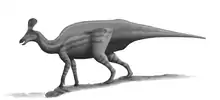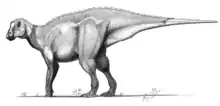Rhabdodontomorpha
Rhabdodontomorpha is a clade of basal iguanodont dinosaurs. This group was named in 2016 in the context of the description, based on Spanish findings of an early member of the Rhabdodontidae. A cladistic analysis was conducted in which it was found that Muttaburrasaurus was the sister species of the Rhabdodontidae sensu Weishampel. Therefore, Paul-Emile Dieudonné, Thierry Tortosa, Fidel Torcida Fernández-Baldor, José Ignacio Canudo and Ignacio Díaz-Martínez defined Rhabdodontomorpha as a nodal clade: the group consisting of the last common ancestor of Rhabdodon priscus Matheron, 1869 and Muttaburrasaurus langdoni Bartholomai and Molnar, 1981; and all its descendants. Within the clade Zalmoxes and Mochlodon are also included.[1] The clade is characterized by the following synapomorphies:[2]
- the outline of the dorsal iliac margin is sigmoidal in dorsal view, with the postacetabular process deflected medialward and the pre-acetabular process deflected laterally
- the dorsal iliac margin is mediolaterally broader and swollen from above the ischiac peduncle anteriorly (present in Muttaburrasaurus) or above the postacetabular process all along (present in Zalmoxes spp.)
- the presence of a weak, dorsally convex ridge on the ventromedial side of their postacetabular process
- the ischiac peduncle of the ilium is lenticular and uniquely anteroposteriorly long
- the acetabulum is noticeably low
| Rhabdodontomorpha | |
|---|---|
 | |
| Muttaburrasaurus mount at the Queensland Museum | |
| Scientific classification | |
| Kingdom: | Animalia |
| Phylum: | Chordata |
| Clade: | Dinosauria |
| Order: | †Ornithischia |
| Suborder: | †Ornithopoda |
| Clade: | †Iguanodontia |
| Clade: | †Rhabdodontomorpha Dieudonné et al., 2016 |
| Subgroups | |
The group consists of small to large plant eaters from Europe and Gondwana. It must have split from other iguanodont groups during the Middle Jurassic.[1] In 2020, the Australian iguanodont Fostoria was also found to belong to this clade.[2]
References
- Dieudonné; et al. (2016). "An Unexpected Early Rhabdodontid from Europe (Lower Cretaceous of Salas de los Infantes, Burgos Province, Spain) and a Re-Examination of Basal Iguanodontian Relationships". PLoS ONE. 11 (6): e0156251. doi:10.1371/journal.pone.0156251. PMC 4917257. PMID 27333279.
- Dieudonné, P.-E.; Cruzado-Caballero, P.; Godefroit, P.; Tortosa, T. (2020-07-20). "A new phylogeny of cerapodan dinosaurs" (PDF). Historical Biology. 0 (0): 1–21. doi:10.1080/08912963.2020.1793979. ISSN 0891-2963.





.jpg.webp)
